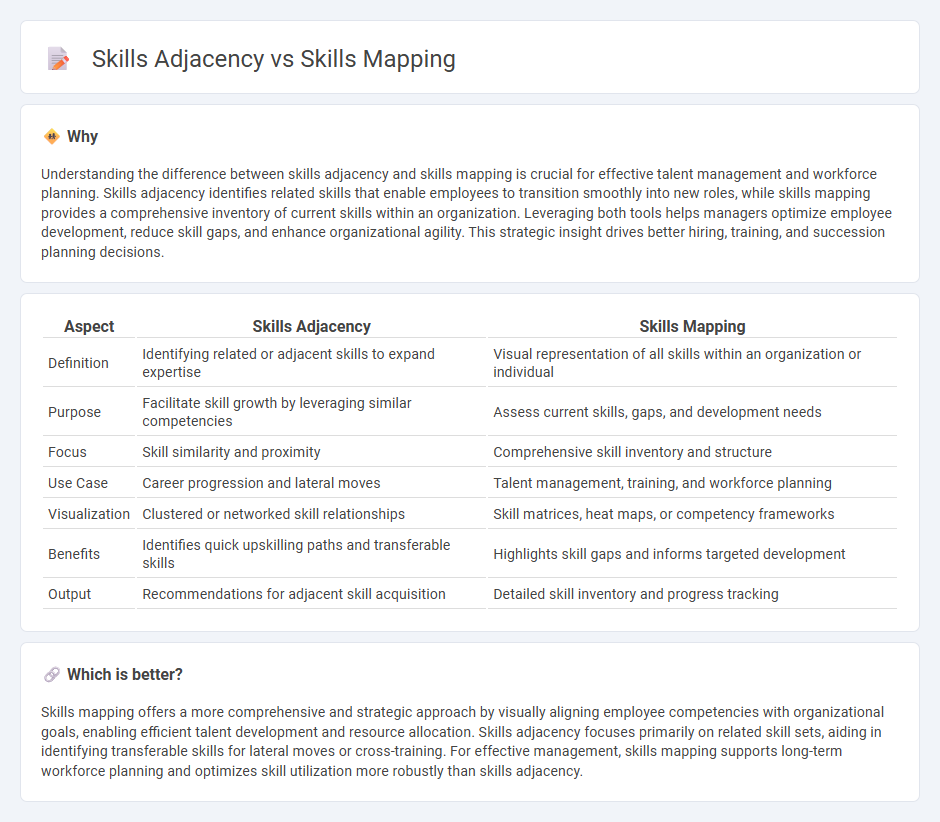
Skills adjacency identifies closely related abilities that facilitate seamless skill transition and development within management roles. Skills mapping systematically visualizes the relationship between existing skills and needed competencies to achieve strategic organizational goals. Explore how mastering these techniques can enhance talent management and workforce planning efficiency.
Why it is important
Understanding the difference between skills adjacency and skills mapping is crucial for effective talent management and workforce planning. Skills adjacency identifies related skills that enable employees to transition smoothly into new roles, while skills mapping provides a comprehensive inventory of current skills within an organization. Leveraging both tools helps managers optimize employee development, reduce skill gaps, and enhance organizational agility. This strategic insight drives better hiring, training, and succession planning decisions.
Comparison Table
| Aspect | Skills Adjacency | Skills Mapping |
|---|---|---|
| Definition | Identifying related or adjacent skills to expand expertise | Visual representation of all skills within an organization or individual |
| Purpose | Facilitate skill growth by leveraging similar competencies | Assess current skills, gaps, and development needs |
| Focus | Skill similarity and proximity | Comprehensive skill inventory and structure |
| Use Case | Career progression and lateral moves | Talent management, training, and workforce planning |
| Visualization | Clustered or networked skill relationships | Skill matrices, heat maps, or competency frameworks |
| Benefits | Identifies quick upskilling paths and transferable skills | Highlights skill gaps and informs targeted development |
| Output | Recommendations for adjacent skill acquisition | Detailed skill inventory and progress tracking |
Which is better?
Skills mapping offers a more comprehensive and strategic approach by visually aligning employee competencies with organizational goals, enabling efficient talent development and resource allocation. Skills adjacency focuses primarily on related skill sets, aiding in identifying transferable skills for lateral moves or cross-training. For effective management, skills mapping supports long-term workforce planning and optimizes skill utilization more robustly than skills adjacency.
Connection
Skills adjacency and skills mapping are closely connected as they both focus on identifying and organizing competencies that enable employees to transition smoothly between related roles. Skills adjacency highlights the proximity of skills based on their similarity or complementary nature, while skills mapping visually represents these relationships to facilitate workforce planning and career development. Together, they optimize talent management by aligning individual capabilities with organizational needs and growth opportunities.
Key Terms
Competency Framework
Skills mapping involves identifying and categorizing specific skills within a competency framework to align employee capabilities with organizational goals. Skills adjacency assesses related or complementary skills that enhance workforce flexibility and support career development within the same competency domain. Explore how integrating skills mapping and adjacency deepens your understanding of workforce potential and drives strategic talent management.
Gap Analysis
Skills mapping identifies the current competencies of employees and aligns them with organizational requirements to highlight existing skill gaps. Skills adjacency evaluates related skills that employees can develop easily based on their current expertise, facilitating efficient gap closure and workforce upskilling. Explore further to understand how these approaches enhance targeted gap analysis and talent development strategies.
Talent Mobility
Skills mapping identifies specific competencies within a workforce to align employee capabilities with organizational needs, enhancing targeted talent development. Skills adjacency explores related or complementary skills that employees can acquire, facilitating lateral or upward movement and expanding talent mobility. Discover how leveraging both approaches optimizes internal career pathways and accelerates workforce agility.
Source and External Links
Skills Mapping Guide: Revolutionize Your Talent Management - This guide explains skills mapping as a process to identify and map required skills against existing ones, aiding in talent management and skill gap identification.
Skills Mapping: Meaning and Examples - Skills mapping is a strategic process to document and analyze skills, competencies, and qualifications, helping HR professionals enhance talent management and succession planning.
What is Skills Mapping? Your 11-Step Implementation Guide - This article provides a comprehensive guide to implementing skills mapping, including matrices to analyze and visualize employee skills against organizational needs.
 dowidth.com
dowidth.com